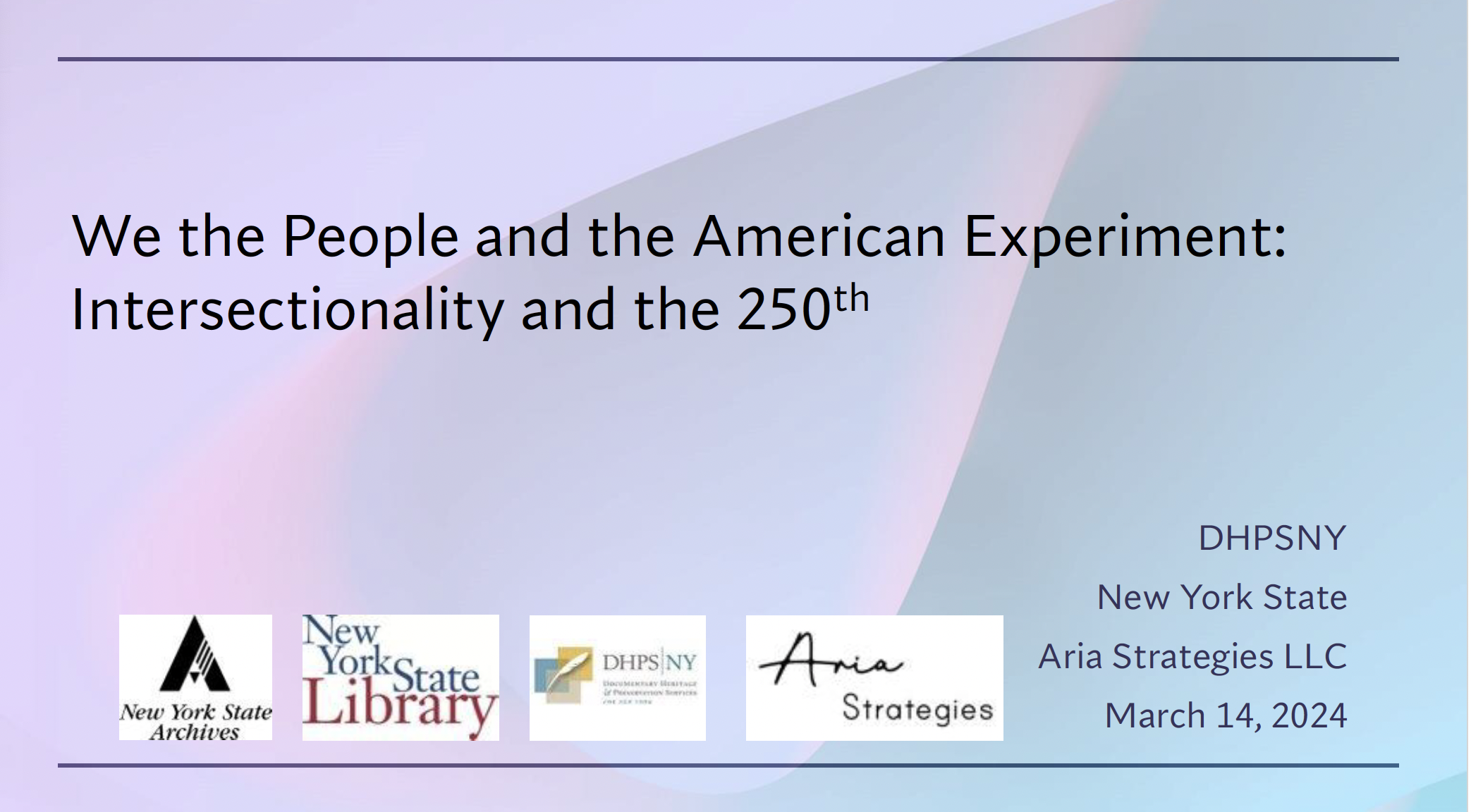Translate
Antiracism Resources: Intersectionality and the 250th

This year's DHPSNY Antiracism Programming takes inspiration from two key resources: the AASLH Making History at 250 Field Guide and the New York State 250th Field Guide. Our overarching question: How do we make our collecting organizations interdisciplinary and representative of the realities of our many New York histories?
Last month, in our latest DHPSNY Dialogue, we delved into the intricacy of New York's past, focusing on the intersectional stories of "We the People" and the ongoing American Experiment within the context of the 250th commemoration and beyond. Here are some highlights and activities from the program, along with resources for further study and links to the slideshow and the recorded portion of the session.
This March, co-facilitator, Tamara Leigh, Editor of Blaque/OUT Magazine, shared the basics of intersectionality with us and invited participants to consider their organizations' collections, exhibits, programs, and institutional planning through the lens of intersectionality. She presented her self-reflection tool and asked us to consider the following:
- List 3 (cultural, historic, social) factors that YOU feel affects comfort, safety and trust in Black, Brown, and Indigenous folks within your organization.
- For each of the three factors listed in #1, list one thing that you are personally doing in your everyday work to address or combat those issues that you identified.
- For each of the three factors listed in #1, list one thing that your agency/org is doing to address or combat those issues that you identified.
- Can you identify what informed your answers to the first question? What has given you those impressions?
These questions can help us identify our need, our plan of action, and our own implicit bias.
Tamara and our other co-facilitator, Aria Camaione-Lind, Principal of ARIA Strategies LLC, also asked participants to grapple with the following questions:
- How can understanding intersectionality and applying it as a lens to our 250th preparation activities help us better understand belonging and civic engagement over time?
- In your community and at your organization, whose stories have been included in the past? Whose have been excluded? How can viewing these included and excluded groups through an intersectional lens help your organization better understand and share stories about those groups?
- How has your organization or community understood civic engagement in the past?
- How can applying an intersectional lens give you a more robust understanding of the different groups of people who engaged in civic action?
Tamara’s self-reflection tool and our participant conversation prompts can help us all to better engage our diverse constituents and get closer to telling their complicated, intersectional stories.
Click here for the recording.
Click here to download the slideshow.
How will you and your organization reach all of your audiences? How will you get hard-to-reach people involved in this work? How will you keep folks engaged over multiple years? You can reach us by email at info@DHPSNY.org, or connect with us on the DHPSNY Facebook page or DHPSNY Community Facebook Group.
Resources for Further Study:
American Alliance of Museums, Strategic Plan: 2022-2025, https://www.aam-us.org/programs/about-aam/american-alliance-of-museums-strategic-plan/.
Chou, Rose L. and Annie Pho, eds. Pushing the Margins: Women of Color and Intersectionality in LIS
Crenshaw, Kimberlé. Critical Race Theory: The Key Writings That Formed the Movement.
Crenshaw, Kimberlé. Mapping the Margins: Intersectionality, Identity Politics and Violence against Women of Color.
Crenshaw, Kimberlé. On Intersectionality: Essential Writings of Kimberlé Crenshaw.
Crenshaw, Kimberlé. The Urgency of Intersectionality. https://www.youtube.com/watch?v=akOe5-UsQ2o
Jimerson, Randall C., "Archives for All: Professional Responsibility and Social Justice," American Archivist, http://americanarchivist.org/doi/pdf/10.17723/aarc.70.2.5n20760751v643m7.
Tolley, Kevin. "The concepts of inclusion and intersectionality; and employing them to grow our audiences," https://www.starnetlibraries.org/the-concepts-of-inclusion-and-intersectionality-and-employing-them-to-grow-our-audiences/.
This post is part of a blog series on sharing information, promoting resources, encouraging discussion, and amplifying the voices of Black, Indigenous, and People of Color (BIPOC) doing antiracism work in archives, museums, history sites, and library special collections. DHPSNY is committed to supporting the diverse network of collecting institutions that safeguard and ensure access to historical records and library research materials across New York State. To learn more, visit our first blog post in the series.
To access the full list of resources in this series, visit our Antiracism Resources links spreadsheet.